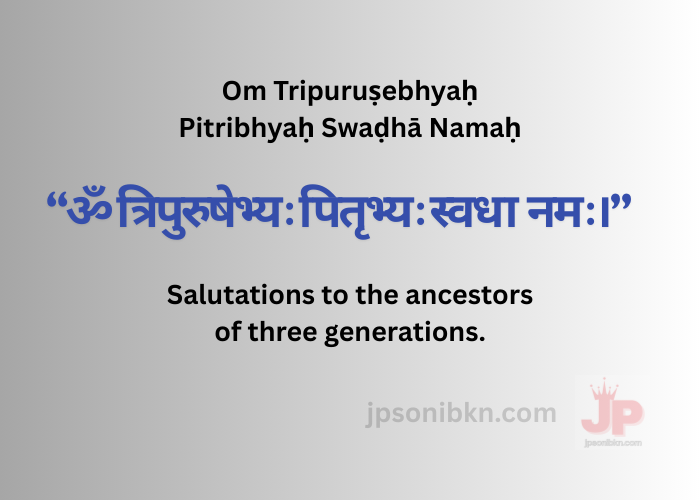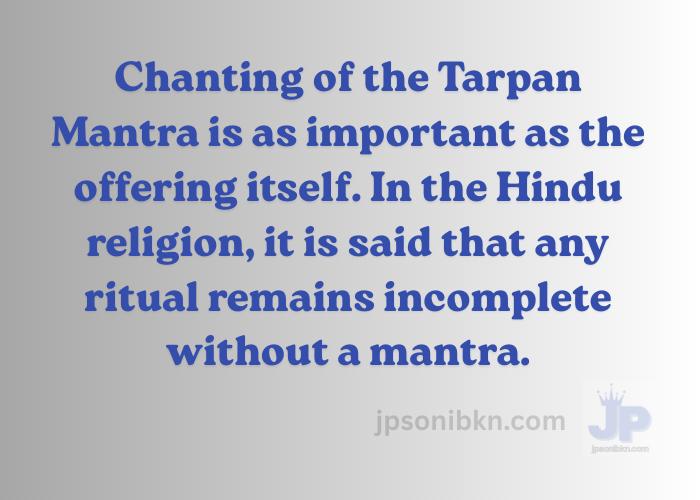Introduction About Tarpan Mantra

In every culture, we are taught to honor our ancestors, as they hold a sacred place in our lives. However, in Hinduism, this practice has much deeper roots and spiritual significance. Tarpan performed during the Shraddha Paksha is one of the most important rituals offered for our ancestors. The offering of water and sesame seeds in the tarpan is a symbol of respect and gratitude.
At the heart of this ritual is the Tarpan Mantra, a very sacred mantra that conveys our devotion in the form of offerings to our ancestors or departed souls. Regarding the Tarpan Mantra, many people believe that by chanting this mantra, our ancestors not only get peace but also get their blessings for health, prosperity, and harmony.
In this article, we will learn about simple ways to perform the ritual at home and also get all the information about what is Tarpan Mantra is and its meaning, importance, types, and benefits.
“The Ultimate Tarpan Mantra for Positive Ancestral Blessings”
What is Tarpan?
The word tarpan comes from the Sanskrit root “trup”, which means to satisfy or please. In short, Tarpan means offering water while chanting mantras, which makes our ancestors happy and satisfied, and we get their blessings. It is not just a ritual, but a way to express our gratitude to those in our family who came before us.
In the scriptures, it has been described as the great duty of a living being to make offerings to the ancestors. Our ancestors made sacrifices for us, due to which we are able to live our lives today without any problem. By offering tarpan to our ancestors, we acknowledge their contribution, remember them, and receive their continuous blessings.
Tarpan is performed during the Pitru Paksha (fortnight dedicated to ancestors), which is usually sixteen days long but can also be performed on special family occasions such as Amavasya (new moon day) or Shraddha ceremonies.

The Importance of the Tarpan Mantra
Offering water and sesame seeds is the physical aspect of Tarpan; the Tarpan mantra is equally important, as this mantra gives it spiritual power.
Vibration generated by the Tarpan mantra:
Through the Tarpan Mantra, we reach our ancestors and get peace from them. Pitra Dosh (ancestral imbalance in the family) is removed. Reciting this mantra strengthens the karmic bond between generations. Positive energy flows in the house, and we are blessed with success and health.
Chanting of the Tarpan Mantra is as important as the offering itself. In the Hindu religion, it is said that any ritual remains incomplete without a mantra.
Commonly Recited Tarpan Mantra
The most commonly used mantra for tarpan is:
- “ॐ पितृभ्यः स्वधा नमः।” (Om Pitribhyaḥ Swaḍhā Namaḥ)
Meaning: “I pay my obeisance to my ancestors with deep reverence and offer them humble offerings.”
This mantra is straightforward but powerful. It contains the essence of humility, gratitude, and devotion. Even people unfamiliar with mantra rituals can chant this mantra sincerely, as it is the least they can do to honor their ancestors.
Variations of Tarpan Mantras
There are variations of the Tarpan mantras depending on the occasion and tradition. Some include:
1. For all ancestors collectively:
- “ॐ सर्वेभ्यः पितृभ्यः स्वधा नमः।” (Om Sarvebhyaḥ Pitribhyaḥ Swaḍhā Namaḥ)
Meaning: Salutations to all the ancestors.
2. For paternal lineage:
- “ॐ पितामहाय नमः।” (Om Pitāmahāya Namaḥ)
Meaning: Salutations to the grandfather’s soul.
3. For maternal lineage:
- “ॐ मातामहाय नमः।” (Om Mātāmahāya Namaḥ)
Meaning: Salutations to the maternal grandfather’s soul.
4. Extended prayer for blessings:
- “ॐ त्रिपुरुषेभ्यः पितृभ्यः स्वधा नमः।” (Om Tripuruṣebhyaḥ Pitribhyaḥ Swaḍhā Namaḥ)
Meaning: Salutations to the ancestors of three generations.
- Offerings can be personalized to honor specific ancestors or entire lineages through the chanting of these mantras.
Scriptural References to Tarpan
The practice of Tarpan is explained in depth in the Vedas and Puranas.…
By churning the Manusmriti, we come to know that performing Tarpan ensures the welfare of both the living and the departed, and in the Garuda Purana, Tarpan has been described as necessary to obtain the blessings of the ancestors. Not only this, there are instances described in the Mahabharata where even great warriors like Bhishma had performed tarpan to honor their lineage.

Thus, chanting the Tarpan Mantra is not just any ritual – it is an ancient spiritual practice supported by great scriptures that brings peace to our ancestors and strength to us.
How to Perform Tarpan with the Mantra
Performing Tarpan does not always require elaborate arrangements. A true offering with devotion is enough. By following the method given below as a guide, you too can easily please your ancestors with the Tarpan Mantra.
Choose a clean place, if possible near a river, pond, or at home with a bowl of clean water, and sit facing south, as this direction is related to the ancestors. For this, we will need water, black sesame seeds, and grass (kusha) if available.
Now take water mixed with sesame seeds in your hand and slowly pour the water on the ground or in a bowl while chanting the Tarpan Mantra. Repeat this process three or more times.
Then close your eyes and remember your ancestors while imagining them. Express your gratitude and ask for peace, guidance, and blessings.
Benefits of Chanting the Tarpan Mantra
- Chanting the Tarpan Mantra gives us spiritual and psychological benefits.
Chanting the Tarpan Mantra helps in liberating and appeasing the spirits of ancestors and removing Pitra Dosh. Also reduces karmic obstacles associated with incomplete duties of ancestors. Enhances unity, love, and prosperity within the family.
Chanting the Tarpan Mantra is helpful in our spiritual development. By chanting it, our connection with roots and tradition deepens. Positive energy flows through the divine waves generated by chanting the Tarpan mantra, which brings about our overall well-being.
Tarpan in Daily Life: Is It Possible?
Most people perform tarpan only during Pitru Paksha, but we can also include it in daily or weekly prayers. Just by offering water with the Tarpan Mantra every morning or on Amavasya day, we get the blessings of our ancestors. Lighting a lamp and remembering ancestors with folded hands is also a type of tarpan, provided it is done with sincerity.

Conclusion
Tarpan Mantra is not just a mantra; it is a bridge that connects us to our lineage and spirituality. Our ancestors play a major role in shaping our lives. His blessings remove invisible obstacles from our lives, bring peace in our lives, and open doors to prosperity.
If rituals are performed honestly, they get power. Whether we chant a short mantra or perform a full ritual, it is devotion that matters most. The goal of Tarpan is to honor your ancestors, remembering them at all times and staying connected with them to invite their blessings into your life.
Frequently Asked Questions (FAQs)
Q 1. What is the ideal time to perform tarpan?
Answer- The best time is Pitru Paksha (16 days dedicated to ancestors), which also includes the new moon day. However, Tarpan can be performed with devotion at any time.
Q 2. Can women perform tarpan?
Answer- Tradition often puts this duty on men, but in the modern age, women can also perform tarpan with equal devotion and sincerity.
Q 3. Do I need a priest to perform a tarpan?
Answer- A priest can guide the rituals, but it is not necessary. A simple offering of water with the Tarpan mantra at home is equally powerful.
Q 4. What if I don’t know my ancestors’ names?
Answer- Even if we do not remember the names of our ancestors, we can offer tarpan to all our ancestors by collectively addressing them with mantras like “Om Sarvebhya: Pitribhya: Swadha Namah”.
Q 5. Does tarpan really remove Pitru Dosha?
Answer- Yes, it is believed that regular offering of Tarpan with Tarpan Mantra pacifies the spirits of ancestors and reduces karmic imbalance, thereby removing Pitra Dosh.
Get Access Now:
jpsonibkn.com
hindi.jpsonibkn.com
